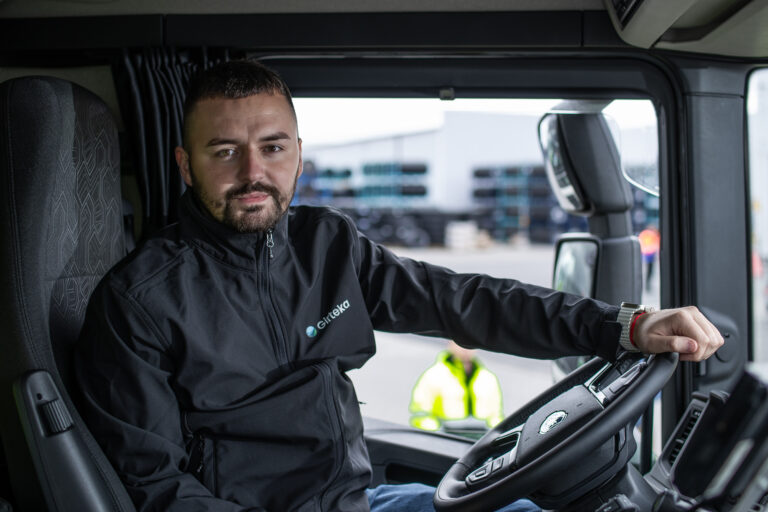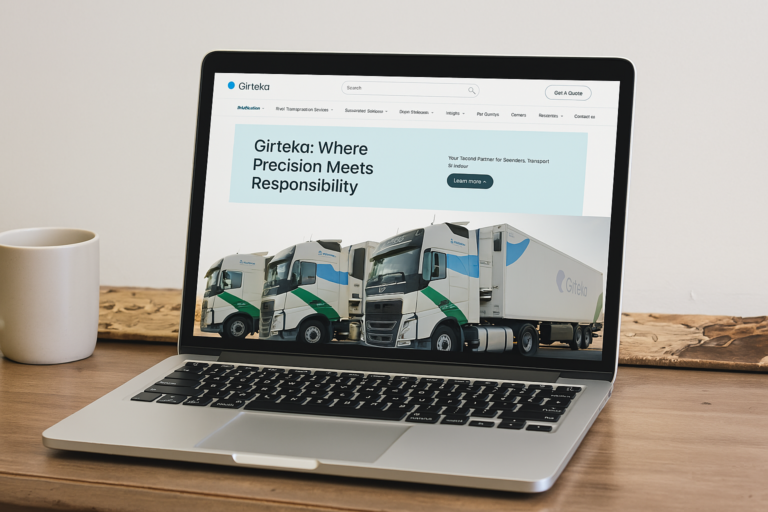Share it:
Solely in the EU, road transport was responsible for 73.2% of all transport greenhouse gas emissions (including domestic transport and international bunkers) in 2022 [1]. With road transportation set to remain the EU’s leading source of transport emissions, the growing focus on sustainability necessitates a systematic shift toward decarbonization. In response, carriers are increasingly leaning into more sustainable transport solutions and investing in digital solutions for business optimization to reduce emissions without compromising on effectiveness from an operational perspective.
According to the International Transport Forum, the demand for freight transport is expected to almost triple by 2050 [2]. As freight volumes grow, so does the urgency to measure, report, and reduce emissions effectively, inviting standardized methodologies that offer a consistent, comparable, and actionable approach to data collection and processing.
After more than a decade of research and data-based advancements, today the Global Logistics Emissions Council (GLEC) Framework is recognized as an international industry standard for calculating and reporting transport emissions. It allows businesses to track their carbon footprint across different transport modes, identify emissions hotspots, and use these insights to drive their decarbonization strategies without compromising efficiency and transparency in their supply chains.
A unified approach to transparency in the transport sector
Before the introduction of the GLEC Framework in 2016, there was no standardized way of measuring emissions, which, in turn, stagnated the efforts to reduce road transport emissions and promote accountability in the EU and beyond. The inability to compare emissions across different modes of transport or suppliers also hindered the possibility of measuring the impact of sustainability-oriented initiatives and business decisions. Developed and published by the Smart Freight Centre (SFC), the GLEC Framework addressed these issues by offering a comprehensive methodology for calculating and reporting logistics greenhouse gases across all modes of transport [3].
This framework provides systematic guidance in terms of boundaries and data sourcing throughout the entire transport chain. It offers different levels of granularity, with reporting requirements ranging from the basic “must-have” to very advanced levels optimized for the highest improvement potential [4].
This methodology classifies emissions into three categories: scope 1, 2, and 3 [5]:
- Scope 1 involves direct emissions from assets owned or controlled by the reporting company.
- Scope 2 refers to indirect emissions from electricity, heat, and steam purchased by the reporting company.
- Scope 3 accounts for emissions from the chain supply chain, including transportation emissions required to move goods from suppliers to the reporting company, and from the reporting company to the end customer.
In combination, these three layers of accounting provide a comprehensive system that allows businesses to harmonize their calculation and reporting of logistics GHG emissions across multi-modal supply chains.
The ISO 14083 standard: origins, holder benefits, and future potential
The GLEC Framework is highly relevant to the transport sector, but it also has broader implications at the administrative level. It served as a methodological foundation for the ISO 14083 standard, which replaced the European Standard EN 16258. The new standard was developed in collaboration between the German Institute for Certification (DIN), members of an ISO (International Organization for Standardization) working group, and the SFC [6].
ISO 14083 applies to all modes of transportation, including land, water, and air, as well as transportation hubs such as ports for both freight and passengers [7]. Unlike the GLEC Framework, however, this standard only distinguishes between direct and indirect emissions [8].
As the focus of regulatory EU bodies increasingly shifts towards decarbonization, adopting clear-cut processes and methods for emissions tracking and business decisions related to it promises not only strategic and competitive advantages. It also offers more flexibility and ease when official regulatory requirements – a step that is pending and likely unavoidable – will come into the picture.
In fact, CountEmissions EU, a proposal for a single methodology for calculating GHG emissions from transport services, is already leading the push in this direction. Put forth by the EU Commission in July 2023, it suggested to reuse the ISO 14083 methodology. Throughout 2024, this proposal progressed through key legislative stages: the TRAN and ENVI committees adopted a joint report, and the EU Parliament voted on its first reading. As of January 2025, trilogue negotiations between Parliament and Council to finalize the regulatory text are ongoing [9]. While the adoption of CountEmissions EU wouldn’t make emission reporting mandatory, logistics entities reporting GHG would need to follow the CountEmissions EU rules.
The GLEC Framework as the backbone for transparent reporting and future compliance
Coming back to the role of the GLEC Framework, it is the primary industry guideline to support the implementation of ISO 14083 and can be effectively implemented by shippers, carriers, and logistics service providers. Furthermore, this methodology is readily aligned with key guiding principles that shape the transport sector today and aim to prepare companies for the challenges of tomorrow [10]:
- Greenhouse Gas Protocol
- Global Green Freight Action Plan
- CDP Reporting
At its core, the GLEC Framework not only outlines the methodology for calculating GHG emissions – it promotes transparency and integrity in the industry by supporting data collection and auditable emissions reporting to facilitate seamless collaboration with governments, investors, and other involved parties [11]. This aspect is already widely recognized and regarded by forward-looking investors, customers, and business partners, positioning businesses who adopt it as responsible and committed to delivering on their sustainability promises [12].
Regarding the internal impact of adopting the GLEC Framework, consistently recording and analyzing GHG emissions is a proven method for achieving long-term sustainability goals. Based on the collected information, as well as good practices from other companies who have adopted this framework, businesses can make strategic, data-backed decisions, effectively evaluate their impact, and track their progress. As examples presented later on will demonstrate, introducing changes centered around lowering the carbon footprint can also bring direct financial gains due to increased business efficiency, optimal resource use, and reduced costs [13].
Practical implementation: main stages and available support structures
According to the Logistics Emissions Accounting & Reduction Network (LEARN), successful adoption of the GLEC methodology includes 5 stages [14]:
- Adopt GLEC Framework
- Integrate it into business processes
- Calculate emissions
- Obtain assurance and report
- Use results for better decisions and actions
Collectively, these actions are designed to bring a significant, multi-layered outcome by allowing businesses to optimize their supply chain efficiency and minimize their carbon footprint. With that said, it is important to note that the GLEC Framework supports precise, individualized emission calculations when high-quality primary data is available, and businesses relying on industry averages may experience less accurate results.
Regarding the implementation process itself, it depends on available resources, current business practices, and staff readiness, which ultimately necessitates a case-by-case approach. For instance, companies that use developed accounting and reporting systems and have access to dedicated staff can implement the GLEC Framework without external help. However, in cases where one or more of these conditions are not met, companies have the option to call in the help of SFC or SFC-accredited partners [15]. By choosing this option, companies can access tools, programs and qualified providers who can deliver emission calculations in conformance with the GLEC Framework. The SFC also provides other resources designed to support companies at various levels of implementation and maintenance of emissions tracking and reporting methodology, such as the GLEC & ISO 14083 Calculation Workshop, GLEC Framework e-training, methodical recommendations for explaining the potential of adopting this methodology to company management, and others [16].
Steps today, strides tomorrow: case studies
Interest in the GLEC Framework has been growing since its first release in 2016. As of January 2025, the methodology has undergone multiple updates, with the latest version (3.1) published in October 2024. More than eight years in, data-backed case studies from various companies not only validate its effectiveness but also provide valuable insights for those still shaping their own approach.
One case study highlighted by the Logistics Emissions Accounting and Reduction Network (LEARN) covers progress achieved by a coolchain logistics solutions provider. Beginning with a common dilemma of integrating the GLEC Framework with other methodologies and tools that are already in place, this provider transitioned from an in-house emissions calculator to the GLEC Framework. Since the initial tool was readily aligned with existing national regulations, the comparison between calculation tool outputs and calculations using the GLEC framework revealed compatibility in most aspects, allowing a relatively easy transition. Additionally, the GLEC Framework provided an even more streamlined approach, leading to more transparent and accurate reporting [17].
Regarding another aspect of the GLEC Framework – the potential of using emissions tracking to inform long-term decision-making – a notable example is the case of VRTO, a terminal operator’s association of one of the major ports in Europe. As container volumes grew by 43% between 2008 and 2014, VRTO implemented the GLEC Framework in order to measure the impact of past business choices and establish a GHG emissions baseline for the future. As a result of this transition, VRTO was able to analyze historical emissions data, set informed sustainability targets, and refine operational strategies. Furthermore, although the number of containers handled by the port continued to grow, GHG emissions per container dropped by 17,85% (in 2014) – mainly due to a shift from fossil fuels to electric-powered operations. Measuring GHG emissions in a consistent and clearly defined way also allowed VRTO to clearly justify the switch from fossil fuels to electricity by quantifying its success [18].
Decarbonization objectives in the EU and ongoing challenges
As the EU continues to move towards long-term sustainability objectives, regulations that apply in the transport sector call for immediate action from carriers on multiple fronts. To note a few, the amended Regulation (EU) 2019/1242 set ambitious CO2 reduction targets for HDVs, mandating reductions of 45% by 2030, 65% by 2035, and 90% by 2040 [19]. Its scope has also been expanded to include medium lorries, further pushing carriers toward systematic fleet upgrades. The EU Emissions Trading System (ETS), including its extension to buildings and road transport (ETS2), aims to incorporate carbon pricing into these sectors starting in 2027. By putting a price on carbon emissions, ETS2 creates a market mechanism that encourages investments in emission reductions. Together with initiatives like the Renewable Energy Directive (RED II) and policies promoting alternative fuels, ETS2 forms part of a broader strategy to achieve the EU’s climate goals.
By providing a consistent and widely adopted method for emissions accounting in logistics, the GLEC Framework not only helps companies comply with these evolving regulations; it creates a foundation for more accurate and fair carbon pricing mechanisms in the industry. With that said, the availability and quality of data are still the main obstacles – primarily due to carriers lacking the resources or technical infrastructure to track all the necessary variables. More specifically, setbacks commonly occur due to incomplete integration of fuel and transport management systems [20] This situation positions digitalized carriers who actively invest in business optimization and strive to stay ahead of regulatory updates as a more reliable, future-proof option.
A common approach to this challenge is automated emissions tracking. By automating their data collection, companies can reduce errors, improve data accuracy, and ensure real-time visibility of emissions performance [21]. To take this a step further, GLEC-compliant API endpoints enable seamless integration of emissions metrics into logistics and supply chain management systems, allowing companies to measure, manage, and optimize their carbon footprint with greater efficiency and accuracy [22].
Another critical factor is employee training. By familiarizing the teams across the supply chain with emissions tracking methodologies, companies can improve reporting consistency and fine-tune their approach to long-term sustainability goals. Finally, strategic partnerships with industry leaders – including sustainability consultants and regulatory bodies – can also help businesses make strides towards future compliance by integrating best practices and supporting smooth integration of advanced tools for emissions management.
Looking ahead: advancing transparency in future emissions reporting
Today, standardized calculations are instrumental in ensuring that emissions are measured transparently and helping businesses optimize their sustainability strategies in alignment with regulatory requirements. But as sustainability regulations continue to evolve, so will the GLEC Framework and existing technologies, pushing companies to integrate new emissions tracking tools for better consistency and accuracy.
The integration of AI and IoT is already transforming the industry – especially through real-time emissions tracking and predictive analytics. These innovations give companies a competitive edge by enabling them to approach situations and decisions that influence their carbon footprint proactively rather than reactively.
Blockchain is another breakthrough when it comes to emissions reporting. It provides a secure, immutable ledger of emissions data, helping businesses verify sustainability claims, enhance accountability, and ensure seamless regulatory compliance.
By embracing these innovations, companies can move beyond compliance and confidently leverage emissions data as a strategic asset, using it to make data-backed decisions and build trust with customers and shareholders.



